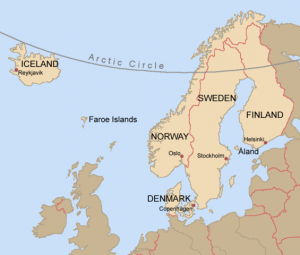By Sarah-Claire Jordan
 A lot of people in the United States in particular (sorry, but we are notorious for not knowing much about the rest of the world), when asked what the difference between Nordic and Scandinavian is, would probably either say “nothing” or that Nordic has to do with the Vikings, but Scandinavian talks about the countries and languages we know today. Neither of those are glaringly “bad” answers, as there are lots of similarities between the two adjectives. Also, it depends on the context: geographic, linguistic, or cultural. Yes, the definitions vary a bit depending on the context, so it’s no wonder many people get confused.
A lot of people in the United States in particular (sorry, but we are notorious for not knowing much about the rest of the world), when asked what the difference between Nordic and Scandinavian is, would probably either say “nothing” or that Nordic has to do with the Vikings, but Scandinavian talks about the countries and languages we know today. Neither of those are glaringly “bad” answers, as there are lots of similarities between the two adjectives. Also, it depends on the context: geographic, linguistic, or cultural. Yes, the definitions vary a bit depending on the context, so it’s no wonder many people get confused.
Geographically, there are only two Scandinavian countries: Sweden and Norway. Technically, part of Finland makes up the Scandinavian Peninsula, but Finland doesn’t count as a Scandinavian country for other reasons. Officially, Denmark is also a Scandinavian country, but that is more for linguistic and cultural reasons as opposed its vicinity to other Scandinavian countries. Denmark shares a lot of history and culture with Sweden and Norway, and the three of them have very similar languages, which leads me to the next way of looking at the difference between Nordic and Scandinavian.
If you want to go at this from a linguistic standpoint, the same group of countries still make up Scandinavia. Norwegian, Swedish, and Danish share a lot of linguistic traits, as well as the same word for Scandinavian. This has a lot to do with the fact that these areas of the world were once part of the territories claimed by the Norsemen in ancient times. It seems confusing, because Norsemen and Nordic seem like they would go together, but you have to remember that there were thousands of different tribes back then, all similar but definitely not the same. Finland, or at least part of it, gets to join the Scandinavian club in terms of language because a percentage of the population speaks Swedish.
This brings us to the most complicated way of looking at the difference, the cultural perspective. Culturally, all of these countries are Nordic: Iceland, Norway, Denmark, Sweden, and Finland. How is that possible, though? Didn’t I just say that only two out of those five were Nordic countries? Yes, I did, but I was speaking geographically and linguistically. If you look at the history of the area, you will see that Sweden, Denmark, and Norway basically ruled the whole area at different points in time.
This political turmoil was confusing for the rest of Europe, so they decided that all countries with Norse ancestry of one kind of another should be called Nordic countries. It’s now used as a general term to talk about Norway, Sweden, Finland, Iceland, Denmark, and even Greenland, but if you want to be more specific you can refer to Norway, Sweden, and Denmark as Scandinavian countries with Scandinavian languages. Depending on who you talk to, they may say that Finland is Scandinavian or Nordic. All you really have to remember is that Finnish is a Nordic language, but Finland could be considered Scandinavian as many people there speak Swedish, a Scandinavian language.
For an overview of our translation expertise, visit our telephone interpreting service page



